Taekwondo 태권도Taekwondo Preschool
Promotion from one geup to the next can proceed rapidly in some schools, since schools often allow geup promotions every two, three, or four months. Students of geup rank learn the most basic techniques first, and then move on to more advanced techniques as they approach first dan. Many of the older and more traditional schools often take longer to allow students to test for higher ranks than newer, more contemporary schools, as they may not have the required testing intervals. View Taekwondo belt levels »

Taekwondo Ranking
( 급 geup )
When you reach senior belt you are expected to guide the junior belts when they are beginning Taekwondo such as showing by example.
Promotion from one geup to the next can proceed rapidly in some schools, since schools often allow geup promotions every two, three, or four months. Students of geup rank learn the most basic techniques first, and then move on to more advanced techniques as they approach first dan. Many of the older and more traditional schools often take longer to allow students to test for higher ranks than newer, more contemporary schools, as they may not have the required testing intervals.
Belt |
Grade Level |
Meaning |
Poomse |
 |
10th Geup | White Belt - "Signifies innocence, as that of the beginning student who has no previous knowledge of Taekwondo". In the 10th geup level ranking, the beginning student learns the most basic techniques such as the Low Block ( 아래막기 arae-makgi ), Middle Block ( 몸통막기 momtong-makgi ), High Block ( 올려막기 olgul-makgi ), Fist Punch ( 주먹 지르기 jumeok-jireugi ), Front Kick ( 앞차기 ap-chagi ), and the Side Kick ( 옆차기 yeop-chagi ). | Kibon Basic #1 |
 |
9th Geup | Yellow Stripe Belt - "White with yellow tag or stripe". To advance from one rank to the next, students typically complete promotion tests in which they demonstrate their proficiency in the various aspects of the art before their teacher or a panel of judges. The student continues to practice the techniques outlined in the previous ranking including improving the Ready Stance ( 기본준비 junbi ), Front Stance ( 앞굽이 ap-kubi ), and Axe Kick ( 내려차기 naeryeo-chagi ). | Taegeuk #1 |
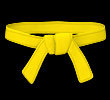 |
8th Geup | Yellow Belt - "Signifies the earth from which a plant sprouts and takes root as the foundation of taekwondo is being laid". The taekwondo student learns new kicks ( 차기 chagi ) such as the Roundhouse Kick ( 돌려차기 dollyeo-chagi ), Back Kick ( 뒤차기 dwi-chagi ), and the various Front Foot Kicks ( 앞발 차기 apbal-chagi ). | Taegeuk #2 |
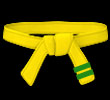 |
7th Geup | Green Stripe Belt - "Yellow with green tag or stripe". The taekwondo student learns more advanced techniques such as the Single Knifehand Outward Block ( 한손날 바깥막기 hansonnal-bakkat-makgi ), Inner Wrist Outer Block ( 안팔목 바깥막기 anpalmok-bakkat-makgi ), Back Stance ( 뒷굽이 dwi-kubi ), Inward Crescent Kick ( 안차기 an-chagi ), and the Outward Crescent Kick ( 바깥차기 bakkat-chagi ). | Taegeuk #3 |
 |
6th Geup | Green Belt - "Signifies the plant's growth as taekwondo skills begin to develop". The student continues to explore the Single Knifehand Outward Block ( 한손날 바깥막기 hansonnal-bakkat-makgi ) and Back Stance ( 뒷굽이 dwi-kubi ) but learns a lot of new techniques in the 6th geup level ranking. The Supported Hand Blade Outward Block ( 손날 거들어 바깥막기 sonnal-kodureo-makgi ), Outside Middle Block ( 바깥막기 momtong-bakkat-makgi ), variations of the Pressing Block ( 눌러막기 nulleo-makgi ), Swallow Hand Blade Inward Strike ( 제비품 손날 안치기 jebipoom-sonnal-an-chigi ), and Hook Kick ( 후려차기 huryeo-chagi ) are some of the techniques introduced. | Taegeuk #4 |
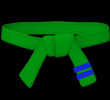 |
5th Geup | Blue Stripe Belt - "Green with blue tag or stripe". The student learns the Cross Stance ( 꼬아서기 koa-sogi ), Hammer Fist Strike ( 메주먹 치기 mejumeok-chigi ), elbow strikes, and Back Knuckle Forward Strike ( 등주먹 앞치기 deung-jumeok-ap-chigi ). For kicking ( 차기 chagi ), the student learns the Counter Kick ( 받아차기 bada-chagi ), Skipping Kick ( 발붙여차기 balbucheo-chagi ), and the Pushing Kick ( 밀어차기 mireo-chagi ). | Taegeuk #5 |
 |
4th Geup | Blue Belt - "Signifies the Heaven towards which the plant matures into a towering tree as training in taekwondo progresses". The student reaches the halfway point in geup ranking and learns much more advanced techniques. The Hand Blade Twisting Outward Block ( 손날 비틀어 바깥막기 sonnal-bitureo-bakkat-makgi ), Spin Hook Kick ( 뒤후려차기 dwi-huryeo-chagi ), and Jumping Back (Thrust) Kick ( 뛰어 뒤차기 ttwieo-dwi-chagi ) are introduced. | Taegeuk #6 |
 |
3rd Geup | Red Stripe Belt - "Blue with red tag or stripe". The taekwondo student is introduced the Scissor Block ( 가위막기 kawi-makgi ), Trunk Push Double Block ( 헤쳐막기 hecho-makgi ), Side Block ( 옆막기 yeop-makgi ), Cat / Tiger Stance ( 범서기 beom-sogi ), and the Target Kick ( 표적차기 pyojeok-chagi ). The student continues to learn to master the Spin Hook Kick ( 뒤후려차기 dwi-huryeo-chagi ) and the Jumping Back (Thrust) Kick ( 뛰어 뒤차기 ttwieo-dwi-chagi ). | Taegeuk #7 |
 |
2nd Geup | Red Belt - "Signifies Danger, cautioning the student to exercise control and warning the opponent to stay away". In the 2nd geup level ranking, the taekwondo student is proficient in most techniques learned from previous rankings. More blocks ( 막기 makgi ) are introduced in red belt such as the Single Hand Wide Open Block ( 외산틀막기 wesanteul-makgi ), Hand Blade Double Block ( 손날 헤쳐막기 sonnal-hecho-makgi ), and the Palm Heel Assisted Block ( 바탕손 거들어 몸통막기 batangson-kodureo-momtong-makgi ). The student is also more experienced participating in taekwondo sparring ( 겨루기 gyeorugi ) practices and tournaments. | Taegeuk #8 |
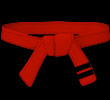 |
1st Geup | Black Stripe Belt - "Red with black tag or stripe". The 1st geup student learns the Log Pushing Posture ( 통밀기준비 tongmilgi-junbi ), Target Punch ( 표적지르기 pyojeok-jireugi ), Palm Heel Forward Strike ( 바탕손 앞치기 batangson-ap-chigi ), Twisting Kick ( 비틀어차기 biteureo-chagi ), and the various Repeating Kick ( 거듭차기 geodeup-chagi ). The student is one level from achieving the 1st Dan Black Belt in taekwondo. | Koryo |
 |
1st Dan | Black Belt (1st Dan) - "Opposite of white, therefore signifying maturity and proficiency in taekwondo; also indicates the wearer's imperviousness to darkness and fear". In the 1st Dan Black Belt ranking the taekwondo student continues to practice and master the techniques learned from geup rankings. When you reach senior belt you are expected to guide the junior belts when they are beginning taekwondo such as showing by example. | Koryo |
 |
2nd Dan | Black Belt (2nd Dan) - "Assistant Instructor (must remain at this rank at least 2 years)" | Keumgang |
 |
3rd Dan | Black Belt (3rd Dan) - "Assistant Instructor (must remain at this rank at least 3 years)" | Taebaek |
 |
4th Dan | Black Belt (4th Dan) - "International Instructor (must remain at this rank at least 4 years). At this point, a person may become a certified Master Instructor ( 사범님 sabeomnim )" | Pyongwon |
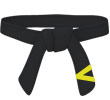 |
5th Dan | Black Belt (5th Dan) - "Instructor (must remain at this rank at least 5 years)" | Sipjin |
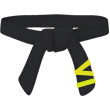 |
6th Dan | Black Belt (6th Dan) - "Instructor (must remain at this rank at least 6 years)" | Jitae |
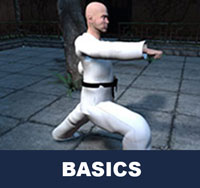
Taekwondo Basics
Here is where you can learn more about Taekwondo 태권도. Knowing the fundamental basics is very important for your learning path as you build your skills and knowledge. There are certain rules that need to be followed to show respect to the master ( 사범님 sabeomnim ), the instructors ( 교사님 gyosannim ), other practitioners and to the martial arts. They vary between schools but many have similar rules and guidelines. For more information View Taekwondo Basics »
There are five tenets defined in the International Taekwondo Federation (ITF) and several more in World Taekwondo (WT).
Courtesy ( 예의 ye-ui ): "Showing courtesy to all, respecting others, having manners as well as maintaining the appropriate etiquette at all times, both within and outside the dojang (도장) (designated training area)." View Taekwondo Tenets »
RESOURCES
This article uses material from the Wikipedia articles "Taekwondo" and "International Taekwondo Federation Ranks", which is released under the Creative Commons Attribution-Share-Alike License 3.0.









